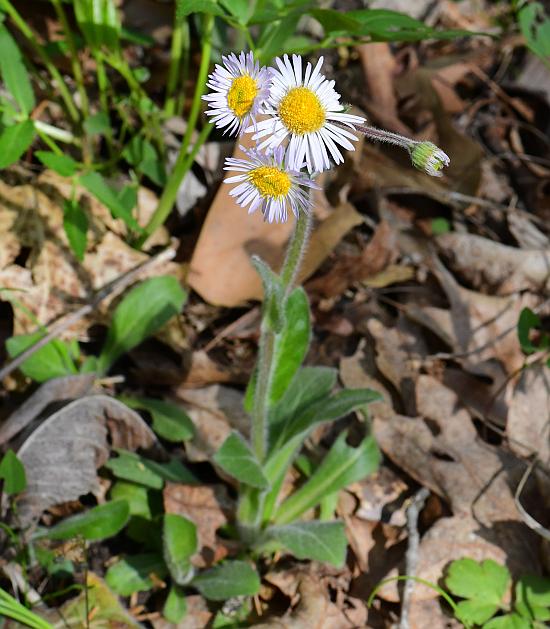Erigeron pulchellus Michx.
Robin's Plantain

Native
CC = 6
CW = 3
MOC = 52
© SRTurner
Erigeron pulchellus Michx.Robin's Plantain | |
 |
Native CC = 6 CW = 3 MOC = 52 |
© SRTurner |
|
Family - Asteraceae/Astereae Habit - Perennial forb with fibrous roots and long, slender rhizomes or stolons, often occurring in large colonies. Stems - Ascending to erect, to 50 cm, solitary, unbranched below the inflorescence, moderately to densely pubescent with relatively long, spreading hairs, especially toward the tip.
Leaves - Basal and alternate. Basal leaves, 2-13 cm long, sessile to short-petiolate, the blade oblanceolate to broadly obovate, usually long-tapered at the base and rounded at the tip, the margins entire or bluntly to less commonly sharply toothed or scalloped, the surfaces and margins moderately to densely pubescent with relatively long, spreading to loosely appressed hairs. Stem leaves usually relatively few, 1-7 cm long, sessile, the blade lanceolate to oblong, oblong-oblanceolate, or ovate, angled or tapered to a pointed tip, rounded to shallowly cordate at the base and clasping the stem, the margins entire or the lowermost leaves with a few teeth toward the tips, the surfaces and margins moderately to densely hairy.
Inflorescence - Solitary heads or small panicles of up to 5 heads.
Heads - Involucre 5-7 mm long, the receptacle 12-20 mm in diameter at flowering, the bracts sparsely to moderately pubescent with more or less spreading hairs and often also minutely glandular.
Florets - Ray florets 50-80, the corolla 6-10 mm long, mostly white with a blue or lavender tint. Disc florets with the corolla 4.5-6.0 mm long. Pappus of the ray and disc florets similar, both with an inner series of 20-35 threadlike bristles 4-5 mm long and often an outer series of relatively few shorter bristles 0.1-0.4 mm long.
Fruits - Achenes 1.3-2.0 mm long, sparsely and inconspicuously hairy.
Flowering - April - June. Habitat - Rocky open woods, thickets, stream edges. Origin - Native to the U.S. Lookalikes - Other species of Erigeron; more broadly, Leucanthemum vulgare, Matricaria chamomilla. Other info. - This species can be found throughout much of Missouri but is apparently absent from the west-central and northwest portions of the state. It also occurs throughout most of the eastern half of the continental U.S., with Missouri lying near the western extent of the plant's natural range. The plant is probably the easiest of the Erigeron species to ID in Missouri because of its densely and conspicuously hairy stems and its relatively large flower heads. The plant spreads by stolons and often forms little colonies. Photographs taken in Linville, NC., 5-10-03 (DETenaglia); also at Rockwoods Reservation, St. Louis County, MO, 04-29-2011, Weldon Spring Conservation Area, St. Charles County, MO, 04-09-2012, Shaw Nature Reserve, Franklin County, MO, 5-1-2022 and 5-14-2022, and Niangua Natural Area, Dallas County, MO, 4-22-2023 (SRTurner). |